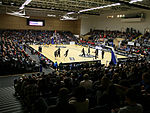Jesmond Metro station
1980 establishments in EnglandNewcastle upon TynePages with no open date in Infobox stationRailway stations in Great Britain opened in 1980Railway stations located underground in the United Kingdom ... and 5 more
Transport in Newcastle upon TyneTransport in Tyne and WearTyne and Wear Metro Green line stationsTyne and Wear Metro Yellow line stationsUse British English from May 2014

Jesmond is a Tyne and Wear Metro station, serving the suburb of Jesmond, Newcastle upon Tyne in Tyne and Wear, England. It joined the network on 11 August 1980, following the opening of the first phase of the network, between Haymarket and Tynemouth via Four Lane Ends.
Excerpt from the Wikipedia article Jesmond Metro station (License: CC BY-SA 3.0, Authors, Images).Jesmond Metro station
A1058, Newcastle upon Tyne Sandyford
Geographical coordinates (GPS) Address External links Nearby Places Show on map
Geographical coordinates (GPS)
| Latitude | Longitude |
|---|---|
| N 54.9828211 ° | E -1.6056954 ° |
Address
Jesmond
A1058
NE2 2AU Newcastle upon Tyne, Sandyford
England, United Kingdom
Open on Google Maps










